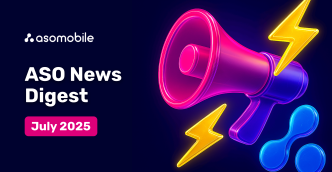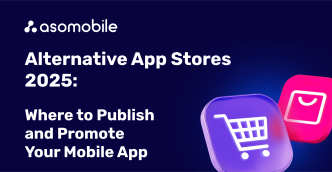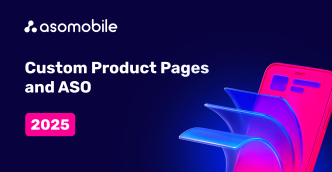How to increase the Retention Rate: four steps of strategy building
Below is the second part of the article clarifying the meaning of Retention Rate. Retention Rate is one of the key metrics that affect the profit of your app. It defines the number of users that go on using the app after a time. An increase in this metric alone just by 5% may increase the profit by 75%.
According to Statista research, the average cost per new customer reaches $4, and it is steadily rising. Therefore, user retention will not only help in increasing profits but also reduce costs.
At the end of the article, you can find a 40% discount coupon for the first month of using ASOMobile - a tool for creating ASO and researching competitors in the mobile app market.
Below we will name four practices to help you create an effective retention strategy.
1. Define the Retention Rate correctly
Each app is unique, so user behavior depends on the category and goal of your product. As for games, daily usage is essential, while for online stores and commercial apps, it's not so much about traffic as it is about purchases.
To provide correct retention evaluation, take into account the user behavior uniqueness.
There are five main retention types:
- Day N Retention: an activity on a specific day after installation (the first, third, seventh, and so on).
- Rolling Retention: the percentage of the people who logged into the app on day N or later.
- Full Retention: the percentage of the people who accessed the app every day for a certain period (e. g. the 1st, 2nd, 3rd, 4th, and 5th day after the installation).
- Return Retention: the percentage of the users who have repeatedly logged into the app on any day after the installation.
- Bracket-Dependent Return Retention: number of users active in the app at least once within the specified period: a week, a month, a year.
The metric that is the most important for optimization analysis depends on the category of your application. For example, Bracket-Dependent Return Retention is more important for "seasonal" applications visited from time to time in case of necessity. Such as ticket and lodgings booking services. For the apps that offer paid subscriptions, the Bracket Retention metric might become especially important. It helps define the number of people ready to pay for the services. If this metric is low, it means that you were not very persuasive about your app's value during the free use period. Add features, change the interface or offer bonuses for long-lived activity.
Analyze every retention metric, compare figures obtained on different days to calculate more accurately such metrics as churn and lifetime. It is the only way you build an efficient user retention strategy at every stage of interaction.
2. Create and analyze a retention curve
A retention curve indicates the changes in the metric at different times. You can monitor its increase or decrease on every stage of interaction with the app.
The curve looks roughly as follows:
The look of the curve allows you to assess the number of users revisiting the app. If this metric is high, the curve starts flattening out after a while, like app #1 curve on the graph. The curve of app #2 does not flatten. That's why before focusing on gaining new users, it is recommended to revise the value proposition.
The curve shift upwards in a few days is a favorable situation. It means that some users were active on the first day and then, for example, on the third day. It is crucial for the apps that are not in use every day: online stores, cabs, and food delivery. In this case, to increase the user return metric, improve the adaptation process, simplify the interface and settings, handle the abandoned buckets and lists of favorites, offer discounts, and make personal offers.
3. Retain at every stage of the lifetime
When you create a retention curve, you can group the users by purchasing stage. It will help reproduce the same sequence for the new users and decrease the churn rate.
Conditionally, there are four groups of users:
- the new users: recently acquired and active;
- the current users: active, often visit the app;
- the return users: stopped visiting the app and then became active again;
- the inactive users: used the app before but are not active anymore.
Before grouping the users, define their lifetime. It spans from the first day of app usage till its removal.
The examples of key lifetime metrics:
- Significant churn occurred on the seventh day. It means that all the users from the first through the seventh day are considered as "new."
- The purchase (the key action) happened on the 30th day. It means it is necessary to retain all the users till that very day.
- Loss of interest and app removal occurred in six months. It means that six months is a period when the product is in use. Try to increase it.
When the users are grouped by time, define the target models for every stage. Monitor the behavior patterns, create portrayals of the users.
For example, three types are characteristic for Youtube:
- heavy content creators: leading bloggers and organizations;
- light content creators: users who created a few videos;
- content consumers: they are just watching the videos and do not create their own.
Create similar groups for your app and then portray a personality that best characterizes your group. Study the characteristics of each group to understand the motivation of users to switch the groups.
Focus on the new clientele. Analyze download statistics to help newcomers to complete the three main steps:
- integration — studying the app and its features;
- appreciating the service value;
- formation of a need.
Upon completion of these three steps, the user will become your loyal customer.
4. Segment the audience and create the patterns
The behavior of the people actively using the app and those who open it when required differs. In e-commerce, segmentation can be made as per purchase price, while in delivery services — based on the number of services per month.
Analyze all your users, and it will help you define the pattern:
- the difference in the behavior of the retained and lost users;
- what steps the person takes before subscribing, purchasing, or registering;
- when a user loses interest in the app;
- the position of inactive users in the funnel.
Besides, define the behavioral pattern depending on the various metrics. For example, the following might affect the person's behavior:
- location;
- internet connection availability;
- gadget type.
When segmenting is completed, create a strategy pattern to retain different user groups. You need to create an action funnel, define the sequence of steps the person needs to take to accomplish something. Pay attention to points in the funnel with the maximum number of people that quit using the app.
Analyze the reason for churn and improve this stage of the funnel. Thus you manage to retain the involved and new users and increase the number of conversions.
Recommendations on retaining the users as per their type
The clients can be attributed to three groups as per their loyalty:
- Recurrent: active 1–2 times a week or less. Usually, they download the app owing to promotion or by chance. These clients are not emotionally attached to the app and might switch to your rivals' app at any time.
- Loyal (experienced): active three or more times a week. They are a long-term source of income for you and your "bush telegraph."
- Idle: they installed the app once, did not appreciate it, and uninstalled it later. Such people have negative user experiences, and more funds will be required to involve them.
Let's analyze how to retain the users depending on their type.
Option 1: Target group selection
It is not possible to work efficiently with all the groups because you cannot increase your budget to such an extent or take into account the interests of all the users.
To select the group you will invest in the most, focus on its value, not the size. Though the number of active users is important, it is more efficient to concentrate on the more profitable group.
During the MAU conference in 2019, CPO Scoop suggested a simple comparison of the difference between retaining users and increasing value. Imagine you are selling two types of T-shirts: for 5 USD and 50 USD. Your budget is enough for retaining either ten users that will buy a T-shirt for 5 USD or three users ready to have the one for 50 USD. The first option will bring you 50 USD. In case you choose the latter you will earn 150. Hence, an investment in three people might be more efficient than an investment in ten.
The selection of a target group depends on your app's category. For "seasonal" apps, cabs, and delivery services, the recurrent users can be more profitable than the loyal ones. As for games, loyal users are more essential than recurrent ones.
Idle users do not bring any money, but they might become your target group. It is relevant when the number of such people is high or when you wish to increase the number of the current users owing to old users comeback.
Option 2: Managing the retention plan
If Option 1 is not your cup of tea, and you would like to work with every user group simultaneously, set different goals for each of them. The goals will reflect what you want to obtain from every user category. Try to set specific quantitative objectives. How many experienced users should you have as a percentage? What is the average frequency of app use?
To make the retention more effective, you can divide the team of developers into several groups where each will be responsible for its type of users. Video streaming service Twitch applied the above method. It divided its team into three groups:
- The Growth Team;
- The Product Team;
- The Reactivation Team.
The Growth Team focuses on improving the adaptation stage. So, the developers got new clients using the targeted messages and offered them a free trial. This approach is also feasible for games. Prolong the free trial till the first captivating moment in the game — something in the plot or complexity level. The free trial shall demonstrate all the specificities of the game and characters to interest the users. The minute you "catch" them, they will be ready to buy your app.
The Product Team is for the interaction with the current users: loyal and recurrent. At this stage, the assessment of user feedback is of importance. It will allow you to understand how the users appreciate your app and the way of its improvement. Lodging booking service Airbnb suggested an effective method of organizing the feedback. It envisaged the pop-up questions that appear after each update. The user sees a window with one question and several answers.
Each person can react immediately to the recently added feature. The user can write about his/her attitude to the new feature and suggest an improvement. Airbnb tactics rely on a belief that the user most likely answers one question instead of completing the questionnaire.
The Reactivation Team focuses on returning the idle users. Twitch suggested analyzing the data of the users that left. After they left, the Reactivation Team targets this group and sends them the content they were interested in before.
You can also suggest a discount or a unique offer to idle users.
To increase user retention, try each of the above four strategies. Assess which one is the most efficient and improve this approach. Create a specific plan and form a team to implement it. It will ease monitoring and improvement of the retention rate.
 Українська
Українська  Русский
Русский  Español
Español 






